Whole Wheat Sandwich Bread
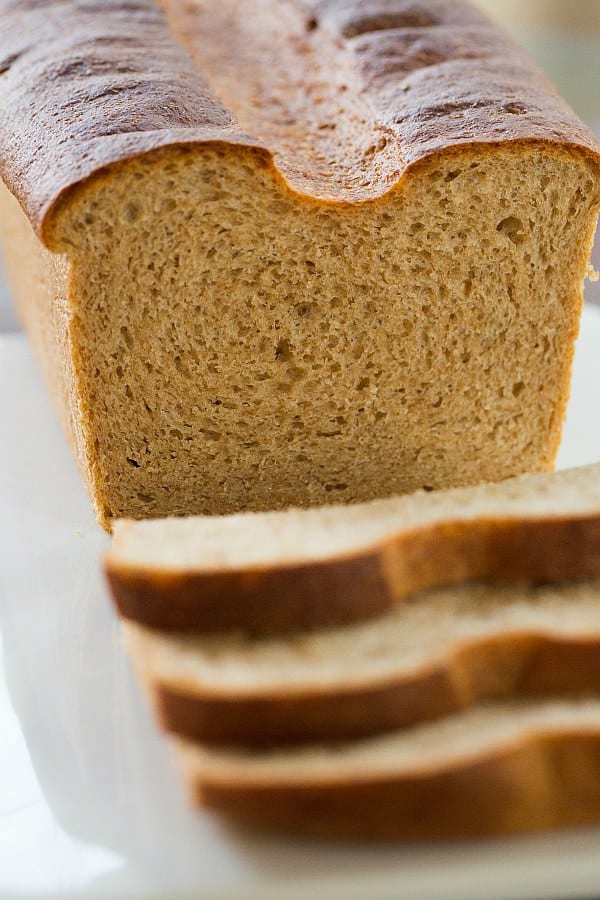
I have woefully neglected my bread-making over the last couple of years. Even though I’ve always to be that person that baked fresh bread every single week, it just didn’t happen. We’ve been keeping a steady stream of grocery store bakery bread in the house, and a couple of weeks ago I decided to revisit my attempt to keep our kitchen stocked with homemade bread. Around the same time, one of my best friends texted me and asked if I had a good whole wheat bread recipe that she could use for making her daughter’s sandwiches for school lunches. She had made the honey-oatmeal bread, but we both agreed that it was better suited for toast – a little bit too heavy for everyday sandwiches. I told her I hadn’t come across anything that I loved, each whole wheat bread recipe that I tried was on the heavy and dense side, not the light and fluffy variety you want for your run-of-the-mill turkey sandwiches.
On Friday, I asked for suggestions and I got tons of responses – thank you! I went ahead and tried the Cook’s Illustrated version, since it was specifically formulated to be a soft and light sandwich bread. Not surprisingly, it was everything I was looking for in a loaf of whole-wheat bread suitable for everyday sandwiches.
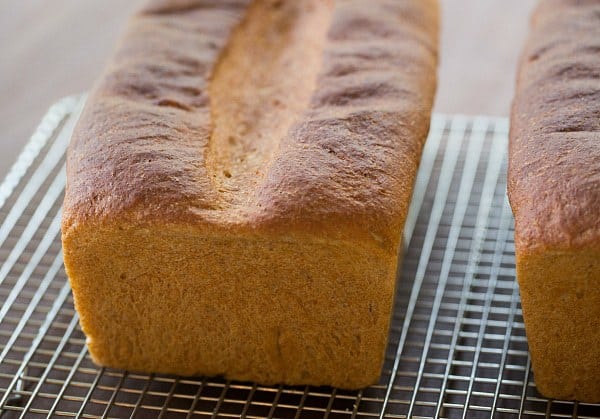
The one caveat with this recipe is that it is more time-consuming than its white bread cousin. You’ll definitely need to plan ahead to make this, but if you have been on the hunt for a great whole wheat sandwich bread, then you’ll love that you found this. Plus, the recipe yields two large 9×5 loaves – you can use one right away and pop the other one in the freezer. Depending on how many sandwiches you go through each week, you could have enough bread for at least two weeks worth of lunches.
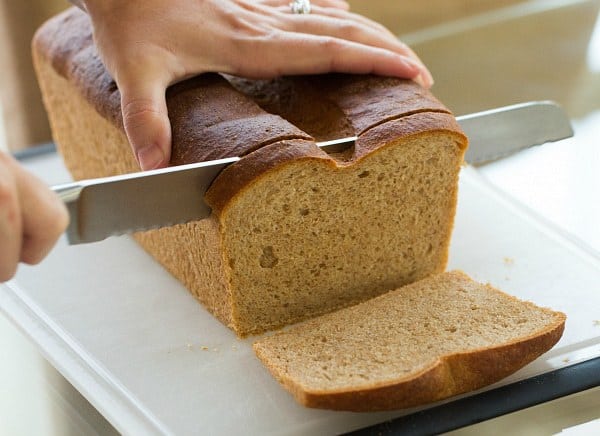
The day before you plan to make the bread, there are two components that you’ll need to prepare. The good news is that they each only take about 5 minutes to mix together!
The biga (pictured below, immediately after mixing and then the next day) acts as a bit of a starter, which helps to develop the flavor of the bread. The soaker, meanwhile, is a combination of whole-wheat flour, wheat germ and milk, and softens the bran, which creates a less-dense loaf of bread. It also helps to cut the bitterness in the flour, giving the bread a sweeter flavor.
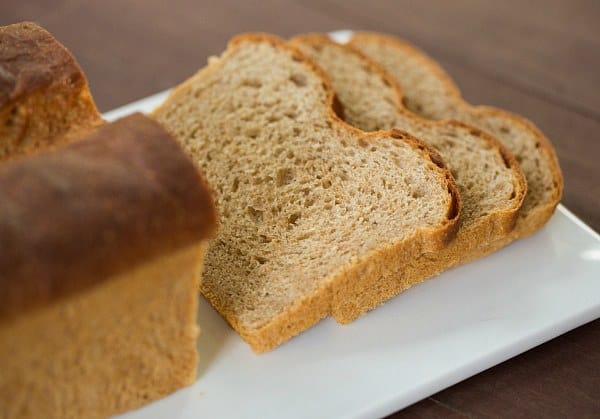
On the day that you bake the bread, there are three different raising times, though very, very little actual hands-on time. After the dough is partially risen the first time, it is folded onto itself multiple times just like the ciabatta bread I made recently. After that, it is left to finish its initial rise, then the loaves are shaped and left to rise again before baking.
To say that I am thrilled with this bread is an understatement. While a thick and hearty bread is great for toast or some “special” sandwiches, I’d rather get filled up by what is between the slices of bread than the bread itself, if that makes sense. This bread is absolutely perfect for your everyday sandwiches, whether you’re eating at home, taking something to work, or packing a lunchbox. It’s light, fluffy, and tastes just wheaty enough with a hint of sweetness.
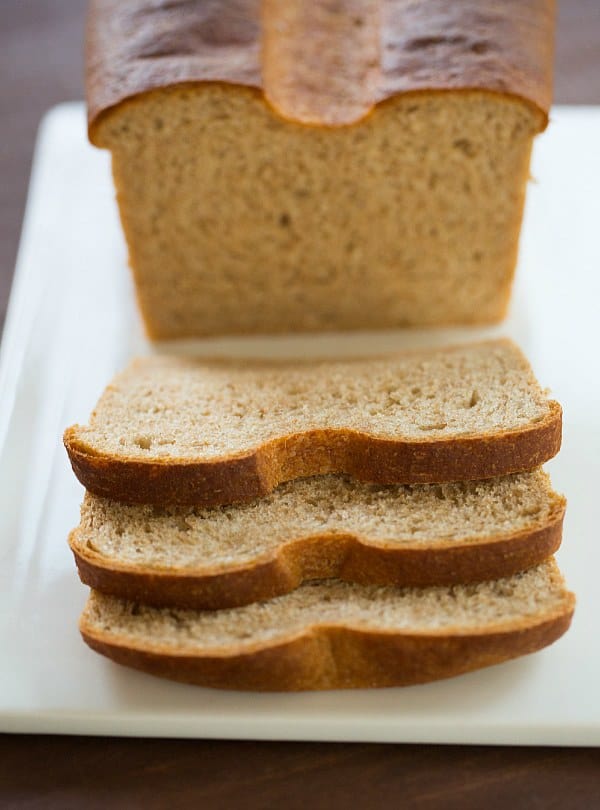
One year ago: DIY: Homemade Greek Yogurt
Two years ago: DIY: Homemade Yellow Cake Batter Mix
Three years ago: Refrigerator Bread and Butter Pickles
Four years ago: Spinach Artichoke Dip
Six years ago: Blueberry-Buttermilk Scones and Fontina-Stuffed Bacon-Wrapped Dates
Seven years ago: Ranch Pretzels
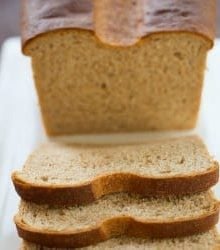
Whole-Wheat Sandwich Bread
Ingredients
For the Biga:
- 2 cups (312 g) bread flour
- 1 cup (240 ml) warm water (100-110 degrees F)
- ½ teaspoon (0.5 teaspoon) instant or rapid-rise yeast
For the Soaker:
- 3 cups (468 g) whole-wheat flour, plus extra for kneading
- ½ cup (57 g) wheat germ
- 2 cups (480 ml) whole milk
For the Dough
- ¼ cup (85 g) honey
- 4 teaspoons table salt
- 2 tablespoons instant or rapid-rise yeast
- 6 tablespoons unsalted butter, softened
- 2 tablespoons vegetable oil
- Bread flour, for work surface
Instructions
- 1. Prepare the Biga: Combine the bread flour, water and yeast in a large bowl and stir with a wooden spoon until a uniform mass forms and no dry flour remains, about 1 minute. Cover the bowl tightly with plastic wrap and let stand at room temperature overnight (at least 8 hours and up to 24 hours).
- 2. Prepare the Soaker: Combine the whole-wheat flour, wheat germ and milk in a large bowl and stir with wooden spoon until a shaggy mass forms, about 1 minute. Turn out the dough onto a lightly floured work surface and knead until smooth, 2 to 3 minutes. Return soaker to the bowl, cover tightly with plastic wrap, and refrigerate overnight (at least 8 hours and up to 24 hours).
- 3. Prepare the Dough: Tear the soaker into 1-inch pieces and place in the bowl of a stand mixer fitted with the dough hook.
- Add the biga, honey, salt, yeast, butter and oil. Mix on low speed until a cohesive mass starts to form, about 2 minutes. Increase speed to medium and knead until the dough is smooth and elastic, 8 to 10 minutes. Turn out dough onto lightly floured counter and knead for 1 minute. The dough will be very soft and slack. Transfer the dough to a large clean, lightly greased bowl. Cover tightly with plastic wrap and allow to rise at room temperature for 45 minutes.
- 4. Lightly flour your fingertips. Gently press down on center of dough to deflate.
- Holding the edge of the dough with your fingertips, fold the dough over itself by gently lifting and folding edge of dough toward the middle. Turn the bowl 90 degrees and fold again. Turn the bowl and fold the dough 6 more times (for a total of 8 folds).
- Cover and allow to rise at room temperature until doubled in volume, about 45 minutes.
- 5. Adjust the oven racks to middle and lowest positions, place a baking stone on the middle rack, and preheat the oven to 400 degrees F (200 degrees C). Spray two 9×5-inch loaf pans with non-stick cooking spray. Transfer the dough to a well-floured work surface and divide into 2 equal pieces. Working with 1 piece of dough at a time, pat each into an 8×17-inch rectangle. With the short side facing you, roll the dough toward you into firm cylinder, keeping the roll taut by tucking it under itself as you go. Turn the loaf seam side up and pinch it closed. Place the loaf seam side down in the prepared loaf pan, pressing it gently into the corners.
- Repeat with the second piece of dough. Cover the loaves loosely with plastic wrap and allow to rise at room temperature until almost doubled in size, 60 to 90 minutes (the top of the loaves should rise about 1 inch above the edge of the pan).
- 6. Place an empty baking pan (not glass!) on the bottom oven rack and bring 2 cups of water to boil on the stove. Using a sharp serrated knife or single-edge razor blade, make one ¼-inch-deep slash lengthwise down the center of each loaf.
- Pour the boiling water into the empty loaf pan on the bottom rack and place the loaves on the baking stone.
- Reduce the oven temperature to 350 degrees (177 degrees C). Bake until the crust is dark brown and the internal temperature registers 200 degrees F (93 degrees C) on an instant-read thermometer, 40 to 50 minutes, rotating the loaves 180 degrees and side to side halfway through baking.
- 7. Transfer the pans to a wire rack and let cool for 5 minutes. Remove the loaves from the pans, return to the wire rack, and cool to room temperature, about 2 hours. The bread should be double-wrapped in plastic wrapped and stored at room temperature for up to 3 days. The loaf can be wrapped with an additional layer of aluminum foil and frozen for up to 1 month.
Notes
Did you make this recipe?
Leave a review below, then snap a picture and tag @thebrowneyedbaker on Instagram so I can see it!





Aloha Michelle, is the soaker supposed to be so wet? There was no way to knead with out adding quite a bit more flour. The Biga was nice and bubbly. The dough came together very nicely. After the last rise when dividing dough to put in pans it seemed like more dough than for 2- 9×5″ loaf pans. I put in and it rose in 30 min. It was at least 1 1/2″ above the edge. I baked for the 40 min and the dough was flowing over the side if the pan. It was 181 degrees when I tookout and the let it cool for 15 min and tipped out of pan. Loaves sunk. :( Help please
I love this recipe! It is by far the best sandwich bread recipe out there. Tastes delicious!!!
Hi Michelle , I want to thank you for your really well thought out recipes . So far I am a total fan of your “ Favorite White bread “ recipe. It’s a stellar recipe that I have made 5 times now.
I wanted to talk about the whole wheat bread recipe . 2 things that I didn’t have on hand were a pizza stone and wheat germ. I have an electric oven and I have to bake on the lower racks to prevent over browning.
I did the hot pan with boiling water when I placed them in the oven and kept my heat at 400 for 8 minutes then turned down to 350.
My loaves sunk in the oven . Not sure why this happened ,but your picture shows a more dense loaf than mine. The flavor is nice ,but a lot of work to get there.
I made this with my freshly ground whole wheat flour. I didn’t add wheat germ since I don’t sift the bran or germ out of the flour, I did add an extra half cup of WWF in place of germ. It was wet but I added an extra cup of bread flour in the final mix. It was still pretty moist but I have never gone wrong with any of your recipes and this one was no exception. 2 big beautiful Fluffy delicious loaves, perfect for soft squishy peanut butter and jelly sandwiches!!
I like all your recipes!
I just wanted to leave a review because I see a lot of people complaining that the dough is too wet. It does seem wetter than other.m breads, but I encourage you not to add any extra flour. It comes together well if you knead it enough, and the finished product is truly out of this world soft. This will be a regular bake in my kitchen!
I don’t have any instant or rapid rise yeast. Can I use regular active dry yeast, and if so, do I need to make any changes to the recipe prep, rise times, etc? Thanks!
p.s. From Helen K, Ontario, Canada. I may have found the answer to some of us having over sticky dough. The recipe calls for “Whole Wheat” flour. I use “Red Fife Stone Ground Whole Grain” flour.
Next time I may reduce both the white bread flour and the water by half in the biga and will add that water to the soaker instead. Along with a cup of whole wheat flour to make up the subtracted white flour. The goal being to keep the whole wheat ratio up a bit more b/c I will still be using the added white flour later on.
BTW, Cook’s Illustrated has an equally delicous bread recipe called: Easy Multigrain Sandwich bread from “Cook’s All Time Best Bread Recipes” magazine Dec. 2018. I make it as directed, but sub 1 oz of Fancy Molasses for 1 oz of the honey. And I use non-oxidized salt.
Hi Michelle! I enjoy your gorgeous and interesting site. I’ve made this recipe twice now and it is delicious. I used the Cook’s Illustrated magazine, but this is the same recipe. Once I made it by hand and once I used my new KA stand mixer. I’m a very experienced bread maker – about 5 decides of making bread. I went online to see if anyone else had the over-stickiness problem and I can see from some of the reviews on your site, that they have. I added more white bread flour whilst kneading it in the mixer in order to give it some substance. And even more later when shaping them – or else the loaves wound have fallen flat in the loaf pan. Surprisingly, I probably used about FOUR extra cups of flour! My loaves are nice and certainly not stuff or dry. I use organic flours, perhaps that makes a difference? Though b/c of the added flour, I should have used a bit more fine non-iodized salt. Thanks!
I made the bread today and it turned out great. I substituted 1/2 cup of the ww flour for rye flour and I didn’t have wheat germ so I used flax seed.
Note that the website currently does not have pictures of the biga as indicated in the text.
I loved the looks of your loaves and the comments below and really want to try this recipe but I have one concern…. I the past when I make slashes in the loaves my bread deflates completely and I end up with dense bread and I am worried that will happen again and given the time required for this recipe I am nervous. Do you know what would have caused the bread to deflate or how to prevent that from happening when slashing the bread? Thank you!
Hi Cassandra, A couple of things could cause that to happen – #1 too heavy of a hand; or (and more likely – I’ve done this) – #2 if the dough has been left to proof for too long, just the slightest touch can cause it to deflate.
I just baked this bread even though I messed up at the end I like the taste…its more towards sour side…I would love to reduce sourness.I left biga at room temp for 24 hours … if I reduce this time should i get less sour taste?
Hi Karuna, Potentially, but it won’t be THAT sour after 24 hours.
learning from few mistakes I did while baking this bread first time…I have been baking this bread quite frequently now… And it turns out perfect every time!
Thanks for sharing.
It gave me encouragement to try few other recipes as well on your blog! :)
I just finished baking this bread….Ohhhhh I am so impatient…first time took it out of oven too early… cooled it so noticed its underdone..so popped it n oven again…when it was done did not let it cool and now its broken…but it tastes so good.. soft… Will do it again…I loved the taste and texture (even after doing it wrong at the end!)
This recipe is fantastic. I’ve made it several times as written, but I really wanted to make it 100% whole wheat. After several flops, I think I’ve finally made the right tweak. I noticed that my favorite 100% whole wheat breads at the store had apple cider vinegar on the ingredient list. I added 2 tablespoons of acv to the soaker with the milk, used whole wheat flour in the biga, and made the rest as written. It turned out soft and fluffy and rose well. Thanks for a great recipe!
Hi Michelle,
Good day!
I already made the white bread and honey oatmeal bread. Both delicious. Based on the comments from the white bread recipe, I can divide the ingredients into two which I did. It worked perfectly fine.
I would like to ask if I can divide the recipe into two for this recipe?
Looking forward to hearing from you soon.
Thanks in advance.
Regards,
Anne
Oooppss… I just saw your comment that I can divide the recipe. Thanks anyway. :)
Would it be possible to make this recipe into buns (following exactly up until the final step)?
Hi Jack, I think that would work okay!
Would this recipe be successful to half, making only one 9 x 5 loaf?
Hi Andrea, Yes, I think that would work just fine.
Fantastic recipe. Thank you. This is so much better than the traditional single-day sandwich bread where you just mix dough, ferment, shape dough, proof, and bake. This is the first homemade sandwich bread recipe I’ve found that actually re-creates much of what makes grocery store sandwich bread so delectable. It’s soft, flexible, squishy, but holds up well to toasting, sandwiches (obviously), or just for snacking. I’ve tried several variations on it and would like to share with everyone.
— I was able up the whole wheat percentage a bit more by adding some vital wheat gluten to the soaker and making the biga be about half bread flour and half whole wheat, and adding a little more vital wheat gluten. I try to use as much whole grain as possible.
— This bread also turns out great if you just use water for the soaker, instead of milk. Milk makes the bread a little softer, but using water helps the gluten really develop for a finished bread slice that can pass the “fold test” without breaking. The dough is wet enough that I did not feel this sacrificed any softness and the finished product was still fantastic.
— I bake mine in an 8×4 pan rather than a 9×5 pan and I still get great results. Proof time is really only about 30 minutes until it’s crowned an inch over the top of the pan and it’s time to throw into the oven. I get great oven spring and I get that classic sandwich bread shape when the loaf bulges over the sides of the pan. The first time I made it, I only had a 9.5×5.5 pan on hand, and after the 90 minute proof if just didn’t have any oomf left and sunk in the middle after baking.
— I don’t bother with the score down the middle. The dough is quite wet and sticky and even an oiled lame can get stuck and mess up the top of the dough. I brush the top of the dough with milk right before putting it in the oven and the crust is flexible enough to survive the impressive oven spring.
Hello Michelle
I was hoping you could point me in the direction for a good white sandwich bread, most recipes I have tried have been on the heavier side.
Thanks
Hi Natasha, Yes! I LOVE this bread – I make a batch every few weeks – one loaf to eat fresh and one to slice and put in the freezer! https://www.browneyedbaker.com/white-bread-recipe/
I finally got around to making this bread, and it came out perfectly! Thanks for the detailed instructions and step by step photos.
This bread dough was crazy sticky and I was basically unable to knead it by hand. I made the recipe per the instructions. Has anyone else had this problem? Did you just add flour gradually until it was manageable?
I have the same problem: I’ve made this recipe twice, and both times the dough was way too wet and sticky to work with. After the second proof I dumped the dough onto the floured counter and it spread like the Blob. I followed the recipe to the letter. It sounds like others posting here have had this problem too.
I added quite a bit more flour (maybe up to 2 c.) as I was doing the kneading step and that helped make the dough less sticky and more cohesive.
Hi there, i want to make bread with your recipe but i don’t have banking stone so what i should use it .
Hi Aneela, You can do this on a baking sheet.
For the soaker, is there a typo on the amount of the flour or the milk? Mine was not even close to being stiff enough to knead. I kept adding flour to have it become a kneadable consistency but I probably added at least a cup and a 1/2 of flour, maybe more. I am in Argentina and didn’t have wheat germ so I just substituted whole wheat flour but I don’t think that would have made that much of a difference with consistency. I have been making bread all my life and I’m old! I would really like this recipe to work but I’m concerned that it will work as written. I’d love to read your response!
Hi Kadi, I double checked and the quantities are correct for the soaker; it could be substituting flour for the wheat germ.
I just made this bread. It is delicious.
Not sure if it should be as soft as it is…sort of like store bought Wonder Bread….
The taste is excellent. It toasts well too. I did forget to slash the top but as soon as I took it out, I realized what I had done. Oh another hint was one loaf starting to collapse into itself on the bottom. As soon as I put a few holes into the bread to let the steam out I reshaped the collapsed area by pulling it out. I was lucky, I was able to save the loaf from becoming our next oven baked french toast. Wonderful directions. One question, I started to use an old pizza stone but it smoked too much to use. How do I clean it?
Bread was successful without using the baking stone. One thing I also did was brush some butter on the top crust while it us still hot, so it stays pliable.
Hi Maureen, I have a plastic scraper that is made specifically for stoneware, I think I got it from Pampered Chef ages ago, but I see that they have them on Amazon: http://www.amazon.com/gp/product/B001BX017W/ref=as_li_tl?ie=UTF8&camp=1789&creative=390957&creativeASIN=B001BX017W&linkCode=as2&tag=broeyebak-20&linkId=DS5N6OW7YBFP3V3J
This may be a silly question, but do you think this will work as well with wheat flour that I grind myself, rather than using commercially purchased flour? I have both, but prefer to use the flour I grind myself. Thanks!
Hi Kim, I have never experimented with grinding my own wheat, so unfortunately I couldn’t say for sure how the bread would be impacted.
Thanks so much for your reply! I’m going to try this recipe later this week. I don’t have a baking stone (yet), so I hope that doesn’t impact the cooking process too much. I haven’t made bread since last winter. I have a hard time baking when it’s warm. I’m the same way with knitting. :)
Hi Michelle,
Just wondering if this bread stays moist over several days to still be suitable for sandwiches. Several loaves I have tried in the past are great the first day or two but then start to get crumbly and don’t stay together very well when eaten as a sandwich.
Hi Theresa, This was good for about 5 days or so (that’s how long it took us to go through a whole loaf). I sliced and froze the other loaf.
hi michele,
i tried this recipe, and it turn out too wet when shaping the loaf. is it that wet?
well, i tweak the recipe though; i used wheat bran instead of wheat germ and i put 2 cups of whole wheat flour and 1 cup bread flour in the soaker, with same yield of water. could it be the cause?
i leave in tropical area.. does it has something to do with humidity as well?
i’m proofing the bread now. finger cross it will turn out well later :)
regards,
mimie
Hi Mimie, The substitutions and alterations could absolutely affect the consistency of the dough. The humidity might be a slight factor, but not as much as the substitutions.
and for update..
it proofed beautifully, but when i put into the oven one loaf spilled the dough while the other one still OK. but when i transfered it to rack it collapsed :( it didn’t bake completely.
well i guess i should try again and stick to the recipe :)
I’ve been cooking forever and I’m just getting into baking. I never made a loaf of bread until last week. I did this over the weekend. Literally, the second time I’ve ever made bread. No stand mixer, so I mixed the soaker, biga and other ingredients the best i could by hand, split it in half, and used the bread blade on the food processor to get it mixed good. Kneaded the hell out of it by hand for a while. This came out PERFECT, exactly like the picture and unbelievably tasty. I just had a roast beef sandwich on bread that I made, with meat I roasted, and it’s a hell of a sense of accomplishment!
I’ve got a got a great oatmeal whole wheat bread recipe that I mix and rise in my bread machine and then take it out and form it and do a second rise in a loaf pan. It is light and wonderful. Email me and I will share :)
To be honest this looks like too much work :S
I’ll stick to the bread machine. :P
There’s nothing like homemade bread, especially when it’s made with whole wheat! Thanks so much for the recipe.
Dear Pittsburgh Sister,
Thank you so much for inspiring my daughter and my patients to cook. OK, it was cupcakes at first… but this is my Whole Wheat Bread recipe (from Cooks Illustrated) and you have seen the importance of learning to cook lots of stuff! I love it that kids can begin with treats and learn to cook healthy things that taste great, too. No shame that Moms and Dads can learn along with them. There is a lost generation who can discover the joy of preparing something that is so tasty and so good for you: THIS loaf of bread.
Now that you are soon to join the League of Mothers with the arrival of a wee one, you can help all mothers with your gifts. You write so beautifully, photograph in amazing, instructive ways… you have the ability to learn and teach the fine art of feeding one’s family…and feeding them well!
I hope you will continue to inspire my daughter with your creativity, and she will continue to ask for my recipes… “Mom, do you think Brown Eyed Baker’s little one would like our Breakfast Cookie Recipe?”
Love,
Dr. Smith
@MDPartner
http://www.PartnersPediatrics.com
These loaves look awesome! I will definitely be trying this recipe. I love the idea of a biga with whole wheat and baking in traditional loaf pans for sandwiches. I have a Peter Reinhart buttermilk bread recipe that I make all the time for sandwiches (and the bread for your tomato soup recipe!) but no “go to” whole wheat. This one sounds like a winner! I can’t wait to try it!
I m reading your blog from Greece and I can say that your recipes are reallyyy good! I want to ask you what exactly is the wheat germ. I don’t know if we have here in Greece and if its easy to get? Can i use something else??? Because I really want to make my sandwich bread. Thank you!!!
Hi Dionysia, This is the wheat germ that is most commonly found in grocery stores here in the U.S.: http://www.kretschmer.com/about-wheatgerm. You could try substituting things like oat bran, wheat bran or flax meal.
Thank you very much for your respond!!!I ll try the oat bran!!!Tomorrow morning I will bake!!!
Sounds great! What kind of pan is that? Doesn’t look like a normal loaf pan or pullman?
Hi Debbi, It is just a regular 9×5 loaf pan. It’s an old Magic Line pan – they all have that lip around the edge for easier handling.
Beautiful! I really like the step by step pictures. Makes it easier when I’m flour-deep in the process. ;)
This looks fantastic!! I have twin boys and can definitely see myself making ALOT of sandwiches in the near future- this could certainly cut down on costs! And health reasons! Hooray! One question though – I only have one bread pan – what would I do with the second loaf of dough while the first is baking? Thanks!!
Hi Kerry, You totally need to get yourself another bread pan! :) There are tons of great recipes that yield two loaves. In the meantime, I’m honestly not sure what you could do with the other half, because without another pan you couldn’t even shape it and have it rising. The only thing you could do is leave it in the bowl, covered, just be aware that sometimes dough can over-rise if left too long, which can result in deflated dough that turns out dense loaves.
Freeze the other loaf after the first rise. When you are ready to use it, let
it thaw, then rise a second time in a loaf pan before you bake as usual.
You could try this method to bake them both in a 9″ square: http://naturalbaker.wordpress.com/2011/08/16/not-enough-loaf-pans/
I’ve also seen people use a single loaf pan set inside a 9×13, leaving room for a total of 3 loaves (like this: http://samann1121.blogspot.com/2011/09/bread-loaf-pan-kludge.html). You might have to experiment with baking times a bit, and the more free-form ones won’t be as pretty.
Thanks for sharing this looks like exactly what I’ve been looking for. I will get started on this today.
can you substitute soy milk for the whole milk?
Hi Sandee, The fat in the milk is an important piece of the bread puzzle. I’m not familiar with soy milk and what the fat content is like. If it’s similar to whole milk, I think you could safely make that substitution. If not, however, I would stick with whole milk.
It looks like we are leaving the oven preheating at 400 degrees for 60-90 minutes while the bread rises in the loaf pans. Does it really need to preheat for that long?
The bread looks amazing! Is there such a thing as whole wheat bread flour? Then it could be 100% whole wheat. ;-)
Thank you for the post. I’m will be making some today!
Hi Lavonne, Anytime you use a baking stone, it needs to be preheated for a substantial amount of time so that it can get nice and hot. The same thing is done when making pizza.
I forgot to answer your question about whole wheat bread flour – unfortunately, it’s not something I’ve ever seen.
Lavonne, regular whole wheat flour is “bread” flour. It’s the higher gluten hard winter wheat that white “bread” flour is made with.
I had the same question at one point, and finally figured this out after a lot of internet research. :)
I agree that I wish this recipe was actually “whole wheat.” Using white bread flour makes it not whole wheat, so the title is misleading.
Hi Rita, Unfortunately, I have to disagree – bread flour and whole wheat flour are two very different types of flours with different properties. They cannot be readily substituted for the other.
Actually white bread flour and whole wheat flour are only different in that one has the bran, germ and endosperm removed, and other leaves it in. But they are both made from the same high gluten, hard winter wheat, as opposed to the soft spring wheat that is best for pastries and quick breads. Whole wheat flour and white “bread” flour are both intended for the same kind of yeast risen recipes. They can be subsituted, but all the good stuff in the whole wheat will make the results very different.
This is one great looking loaf of wheat bread. Mine have always been too dense and squat. I appreciate being able to see your step by step pictures. I’ve never seen a bread recipe that requires a “biga” , “soaker” & “dough” . . . I have to admit my laziness: I saw this CI recipe and immediately dismissed it because I didn’t want to sit and read through their process when I saw biga, soaker & dough. You did a GREAT job on your post and process of this recipe. YOU make me want to give this recipe a try. Thanks!
This is my go-to whole wheat sandwich bread recipe. I LOVE it. It turns out beautiful and tasty loaves ever time!
I was just thinking last night that I needed to start making whole wheat bread instead of white. I will try this this weekend.
I am going to make this for sure. I hate all the additives and ingredients I cannot spell nor pronounce in the store bought bread. Thanks so much for sharing.
I too made lots of bread and then let it go. I never did get a good light wheat. Thank you for this one! Can’t wait to get back to baking good bread!
can we leave out wheat germ? the bread looks perfect,
I haven’t tried omitting it, so I couldn’t say what effect that might have.
I misread the recipe & used 85 g wheat bran instead of 85 g wheat germ, and the bread is still fluffy and delicious. Best wheat bread I’ve ever made — I am so happy with this bread! (though I will try it with the germ next time just to see what the original is like) Thanks for a great recipe!
Oops — 57 g, not 85 g.
Wow. This is super impressive, and the step-by-step pics are amazing! Whole wheat can be hard to do, but this bread is so clearly fluffy and delicious!
Looks so beautiful BEB.. Totally agree with Averie Cooks, very professional. Great job….as always :)
Your bread looks perfect! Can’t wait to try it!
Your bread is beautiful! About two years ago I was getting so many requests for whole wheat bread b/c I was in a (white) bread-making phase and it took me forever to get a soft, not dry, not dense, wheat bread – finally did it but not without lots of effort. I wish I knew the CI recipe existed because it looks like a winner! Your loaves look totally professional!